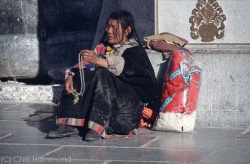Difference between revisions of "Influences"
m (Text replacement - "]]]" to "]])") |
m (Text replacement - "[[[" to "([[") |
||
| Line 10: | Line 10: | ||
While some continued to enjoy their homes, families, and work, a few developed a [[thirst]] for [[spiritual]] [[attainment]] so strong that they began to {{Wiki|renounce}} [[worldly]] possessions and [[family]] connections in order to devote themselves completely to [[meditation]] and other [[spiritual practices]]. They were called [[shramanas]], or renunciants. [[Spiritual]] [[teachers]] made themselves available to those who wanted guidance, [[teaching]] [[asceticism]], [[meditation]], and [[yogic practices]]. The [[spiritual]] heat, or [[tapas]], generated by [[spiritual practice]] was regarded as {{Wiki|equivalent}} to the [[fire]] of the [[sacrifices]] that had been the focal point of the old [[tradition]]. Thus was the old [[tradition]] internalized and [[transformed]]. | While some continued to enjoy their homes, families, and work, a few developed a [[thirst]] for [[spiritual]] [[attainment]] so strong that they began to {{Wiki|renounce}} [[worldly]] possessions and [[family]] connections in order to devote themselves completely to [[meditation]] and other [[spiritual practices]]. They were called [[shramanas]], or renunciants. [[Spiritual]] [[teachers]] made themselves available to those who wanted guidance, [[teaching]] [[asceticism]], [[meditation]], and [[yogic practices]]. The [[spiritual]] heat, or [[tapas]], generated by [[spiritual practice]] was regarded as {{Wiki|equivalent}} to the [[fire]] of the [[sacrifices]] that had been the focal point of the old [[tradition]]. Thus was the old [[tradition]] internalized and [[transformed]]. | ||
| − | A new collection of [[religious]] texts, called the [[Wikipedia:Upanishads|Upanishads]], or "sitting by the | + | A new collection of [[religious]] texts, called the [[Wikipedia:Upanishads|Upanishads]], or "sitting by the ([[spiritual]]) [[teacher]]," is a record of some of these teachings. Many of the [[Wikipedia:Upanishads|Upanishads]] contain the [[idea]] that one's [[individual self]], or [[atman]], is part of the [[ultimate reality]], or [[Brahman]]. Through [[meditation]], an {{Wiki|individual}} could attain [[moksha]], or [[spiritual]] [[liberation]], simply by [[realizing]] the [[true nature]] of the [[self]]. This [[release]] was a way of transcending [[samsara]], the [[endless]] [[cycle of death and rebirth]]. |
The [[Buddha's enlightenment]] would take that [[realization]] a step further, as he [[taught]] that there was no {{Wiki|individual}} ([[anatta]]). The [[experience]] of a separate [[self]] is only an [[illusion]]. If there is [[no self]], there is nothing to [[accumulate]] [[karma]], nothing to be [[reborn]]. To realize that there is [[no self]] is to be {{Wiki|liberated}} from [[samsara]] forever. | The [[Buddha's enlightenment]] would take that [[realization]] a step further, as he [[taught]] that there was no {{Wiki|individual}} ([[anatta]]). The [[experience]] of a separate [[self]] is only an [[illusion]]. If there is [[no self]], there is nothing to [[accumulate]] [[karma]], nothing to be [[reborn]]. To realize that there is [[no self]] is to be {{Wiki|liberated}} from [[samsara]] forever. | ||
Latest revision as of 05:44, 4 April 2016
by: Julia Hardy
At the time of the Buddha's birth, a religious tradition based on sacrifice to powerful and sometimes capricious deities had dominated the land we now call India since 1500 B.C.E., but was yielding to new religious ideas that had been emerging for several centuries. Among these were karma and reincarnation, which had been readily adopted, and may have represented the revival and reconceptualization of ancient ideas already present within the culture.
According to this structure of beliefs, one's social status was a result of one's karma. Deeds in previous lives determined the level of one's rebirth. Social inequalities were thus justified by religion, in a land where social mobility was impossible. This system left no place for arguments for social justice or equality. Because upward movement was believed to require many lifetimes, those of the lower classes now had the dual burden of hopelessness in life and little hope of betterment for lifetimes to come.
At the same time, the region was undergoing political and social change as new city states linked by trade replaced older agriculturally based communities bound by ties of kinship. A growing number of merchants had attained economic success, but their social and religious status was limited by the caste system. Additionally, trade routes across Asia — most notably the renowned Silk Route — brought new social and religious ideas to the northern Indian subcontinent from China and central Asia. The new rulers and the merchants were eager for a religion that awarded them higher social status as well as the opportunity to attain salvation, which at the time was believed to be possible only for those of the highest caste, the priests.
While some continued to enjoy their homes, families, and work, a few developed a thirst for spiritual attainment so strong that they began to renounce worldly possessions and family connections in order to devote themselves completely to meditation and other spiritual practices. They were called shramanas, or renunciants. Spiritual teachers made themselves available to those who wanted guidance, teaching asceticism, meditation, and yogic practices. The spiritual heat, or tapas, generated by spiritual practice was regarded as equivalent to the fire of the sacrifices that had been the focal point of the old tradition. Thus was the old tradition internalized and transformed.
A new collection of religious texts, called the Upanishads, or "sitting by the (spiritual) teacher," is a record of some of these teachings. Many of the Upanishads contain the idea that one's individual self, or atman, is part of the ultimate reality, or Brahman. Through meditation, an individual could attain moksha, or spiritual liberation, simply by realizing the true nature of the self. This release was a way of transcending samsara, the endless cycle of death and rebirth.
The Buddha's enlightenment would take that realization a step further, as he taught that there was no individual (anatta). The experience of a separate self is only an illusion. If there is no self, there is nothing to accumulate karma, nothing to be reborn. To realize that there is no self is to be liberated from samsara forever.
